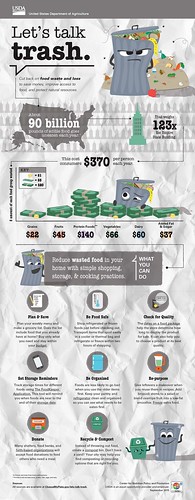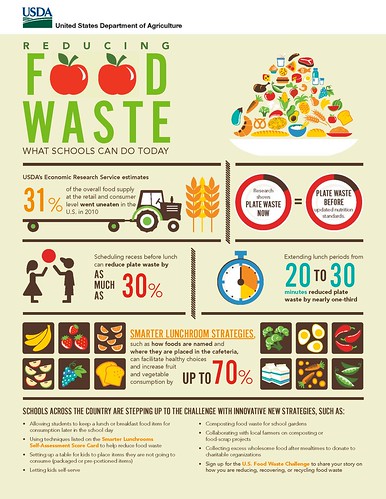
Looking for a way to stretch your food dollars? Would an extra $30 per month for each person in your household help? That’s about $370 per person per year, or almost $1,500 for a family of four. That’s the amount of money USDA estimates the average American spends on food that’s not eaten. It is the equivalent of approximately 2 months’ worth of groceries in a year.
Reducing food loss and waste is an important part of maximizing household budgets. USDA has initiated a number of projects to help consumers reduce wasted food and improve overall nutrition. Most recently, USDA’s Center for Nutrition Policy and Promotion (CNPP) launched a new section on ChooseMyPlate.gov to raise awareness about how much edible food is wasted nationwide, along with a range of resources supporting food waste reduction efforts, including a new infographic titled “Let’s Talk Trash.” There are also tips on ways to reduce food waste at home.
Since the launch of MyPlate in 2011, ChooseMyPlate.gov has become a popular resource for consumers seeking information on nutrition, with more than 51 million visitors to the web site since 2011. Facts about food waste and loss, as well as tips to help consumers reduce waste, are valuable additions to ChooseMyPlate.gov as USDA strives to educate consumers about achieving affordable, nutritious diets.

Sometimes consumers throw away wholesome food because they are confused about how to safely store it or the meaning of dates stamped on the label. USDA’s Food Safety and Inspection Service (FSIS) works to inform consumers about the importance of safe food storage as a means of reducing the risk of foodborne illness. As part of its food waste reduction outreach, FSIS recently updated the safe-storage and date-labeling information on their website. In spring 2015, USDA also launched (in partnership with the Food Marketing Institute and Cornell University) a FoodKeeper App to provide consumers with easy access to clear, scientific information on food storage, proper storage temperatures, food product dating, and expiration dates.
To help educate children about nutritious diets and food waste, USDA’s Food and Nutrition Service (FNS) has initiated programs in the National School Lunch Program and School Breakfast Program to promote waste reduction. FNS offers strategies to help schools reduce food waste by scheduling recess before lunch, extending the lunch period, and creating lunch lines conducive to healthful, waste-free meal choices. Schools are also encouraged to set up food share tables and donate wholesome, excess school food to local hunger relief organizations. In 2014, FNS created an infographic titled, “Reducing Food Waste – What Schools Can Do Today.” The infographic explains the issue of wasted food and offers a few simple strategies to help schools reduce food waste.

On September 16, 2015, Agriculture Secretary Tom Vilsack and Environmental Protection Agency Deputy Administrator Stan Meiburg announced the United States' first-ever national food waste reduction goal, calling for a 50-percent reduction by 2030. As part of this effort, the federal government will lead a new partnership with charitable organizations, faith-based organizations, the private sector and local, state and tribal governments to reduce food loss and waste in order to improve food security and conserve our nation's natural resources.
